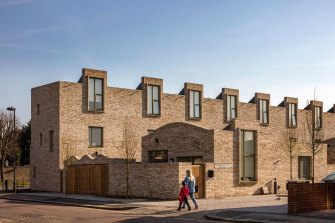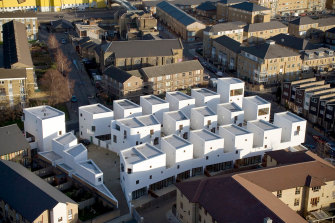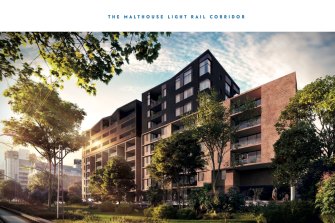A ban on dark roofs Its a furphy minister but heres what really makes me hit the roof
It’s the old missing middle. If politics is the art of making dark acts seem bringers of light, Planning Minister Rob Stokes scored last week in “banning†dark roofs for new suburbs. There were headlines. Even the green press welcomed it as a step towards climate decency, declaring: “NSW government finally sees the light, ditches dark roofs.†Hardly.
This was no green shoot. It was the bleached tip of something much darker: the ongoing exacerbation of both climate change and housing inequality.

Darker roofs contribute to western Sydney’s heat island effect by creating more radiant heat and higher energy consumption.Credit:Wolter Peeters
For a start, there is no ban. That was classic misdirection. What the development control plan for the Wilton Growth Area actually says is: “Residential building design is to use, where possible … lighter coloured roofs.†Everyone headlined the “lighter roofs†but the critical phrase is actually “where possibleâ€.
“Where possible†appears 11 times in the document. It covers biodiversity protection, mature trees, pedestrian access, riparian zones and disability access with a loophole bigger than the Wilton Growth Area and all of its road-squashed koalas combined.
Seriously? Where possible? What could make a pale roof impossible? Aerial camouflage? Religious objection? Paint shortage? “Where possible†is the kind of regulatory emulsifier planners chuck in when they want to make a bad rule to look like a good one while actually changing nothing. They make it floppy and non-stick.
But even if the ban was real, you can’t just approve another 20,000-odd new houses on precious farmland and koala habitat a full 80 kilometres from Sydney with no hope â€" ever - of public transport then buy your way back to heaven with a bit of paint. It’s quite clear. In the face of climate catastrophe, we should not be approving greenfield sprawl at all. Period.
Yet, when I said that on Twitter, one of those faceless anonyms knee-jerked back: “You don’t like vertical highrise like the Fish Market development, you don’t like horizontal sprawl, you don’t explain how medium density is economically viable.†And it’s this assumption â€" that it’s either endless sprawl or 30-storey towers, one or the other, no in-between â€" that is destroying Sydney. This is the missing middle.
Suburbia was predicated on giving every family the space, autonomy and access previously reserved for nobility. It was a dream of equality, but we know now that it was always impossible â€" economically, ecologically, geometrically. The dream was a hallucination.
To be delightful, suburbia requires so much road, generates so much carbon, devours so much land, destroys so much biodiversity, forgoes so much beauty and produces so much social isolation, depression and obesity that the city you produce is sensory deprivation in built form. You end up with two soulless extremes, a puddle of sprawl surrounding clusters of towers that are a form of vertical sprawl. Stokes’ Sydney.
Housing patterns that offer survival, equality and delight lie between the two extremes. (By equality, of course, I don’t mean sameness. It’s towers and burbs that produce dull uniformity. I mean the critical part housing plays in both equality of opportunity and generational justice. We need houses that enable the flowering of talent without destroying climate.)

Peter Barber architect, social rented housing Ordnance Road, Enfield, London
There are many traditional examples, from Vienna’s glorious 18th century courtyard apartments and Barcelona’s 1920s version to London’s six-storey garden squares, San Francisco’s three-storey villas and Sydney’s inner-city terraces. All combine the community, health and eco-benefits of urban living with the garden joys of suburbia.
There are also more recent reinventions of the type, mostly from the 60s and 70s when the high-density low-rise ideal became a grail, attracting some of the best â€" and highest â€" minds in the business.
Atelier Five’s lovely, greenery-draped, three-storeyed concrete Halen estate near Berne (1961) was an early and brilliant example. Another that rightly achieved cult status was the Alexandra Road estate in the London Borough of Camden (1968) by Neave Brown, who wisely argued tower-living should be reserved for the wealthy. Similarly, the 1970s Philadelphia housing by American architect and theorist Louis Sauer (who now, at 93, lives in Launceston) was very fine, dignifying work.

Peter Barber, Donnybrook Gardens, Tower Hamlets, London
Recent versions are fewer, especially in Sydney. There’s Moore Park Gardens, Redfern, designed by Peter Stronach in the 1980s. With its intricate byways, varied form and luscious planting, this is still one of the best. And there’s Hassell’s lovely Flour Mills development for EG in Summer Hill. Like Moore Park Gardens, this involves adaptive re-use of old fabric to enrich its feel. But it is also a fine piece of design and of community-making, with handsome architecture, loved public spaces and a park that is used night and day.

A rare gem: the Flour Mill at Summer Hill.
These are developments you can look at and think, yes, that could be home. Why so few? Not because they are inherently unviable. The brilliant Peter Barber does similar and better things in the uber-expensive London, like the lovely Moroccan-feel Donnybrook Gardens in Tower Hamlets. Some, like his Ordnance Road housing, Enfield, is social for-rent housing, but still lovely.
High-density low-rise housing is rare because we’ve swallowed the furphy articulated by my anonymous heckler: that it’s somehow unviable. Wrong. Viability is an artefact, a made thing, a product of government policy. If you zone for 30 storeys, land value rockets so of course low-rise becomes unviable. Similarly, if you hand-wring in favour of medium density but shove responsibility onto councils, for whom it is a political nightmare, it’s not going to happen. But all this is entirely in government control.
Thanks for your pale-roof greenwash, Mr Stokes, but forcing Sydney into a choice between squitty apartments and godforsaken suburbs betrays our humanity, our city and our future.